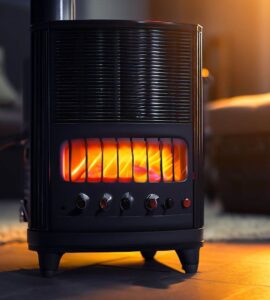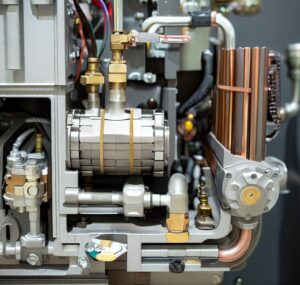Table of Contents
Gas heaters are a popular heating option for homes and buildings. They use natural gas or propane to generate heat. A burner is responsible for igniting the gas and producing a flame. The heat from this flame is then transferred to a heat exchanger, which warms the air or water. Additionally, gas heaters also have safety features. Flame detectors monitor if the flame is present or not. If the flame is extinguished, the gas valve will shut off. Ventilation systems are in place to expel any combustion byproducts.
Gas heaters are appreciated for their efficiency. They quickly and effectively warm up spaces, making them a great choice. Additionally, they are energy-efficient as they convert most of the fuel’s energy into heat. We experienced this firsthand when our old house’s gas heater malfunctioned during winter. We quickly called a professional and they fixed the issue in no time.

Gas heaters provide warmth during colder months. Understanding the basics of a gas heater can save you from a cold surprise.
Understanding the basics of a gas heater
Gas heaters help to heat homes and provide hot water.
- Fuel, usually natural gas or propane, is burned to create heat. This heat is transferred through a heat exchanger to warm air or water which is circulated around the house.
- The gas valve opens and releases fuel to the burner. A spark or pilot light ignites the fuel to create a flame. This flame heats the heat exchanger which transfers heat to the air or water.
- A blower fan pushes air over the heat exchanger for central heating systems, and a pump circulates water for hot water systems. Safety features like a flame detector keep gas from leaking, and ventilation systems remove any exhaust gases.
I once had an old gas heater that was not working well. I called a service company, and they replaced worn out parts. After servicing, it worked perfectly and efficiently. Regular maintenance is key for optimal performance and energy efficiency.
To keep your gas heater running well, understanding how it works helps you troubleshoot issues. With proper care and maintenance, your gas heater will keep you warm and cozy.
Key Notes
- 1. Gas heaters work by burning natural gas or propane to produce heat, which is then distributed throughout a space.
- 2. The combustion process in a gas heater involves a burner, a heat exchanger, and a flue to safely remove exhaust gases.
- 3. Gas heaters are efficient and provide instant heat, making them a popular choice for heating homes and commercial spaces.
- 4. It is important to properly maintain and service gas heaters to ensure their safe and efficient operation.
- 5. Gas heaters should be installed by a professional to ensure proper ventilation and compliance with safety regulations.
- 6. Gas heaters can be controlled using a thermostat, allowing users to adjust the temperature to their desired level.
- 7. Gas heaters are a cost-effective heating option, as natural gas and propane tend to be cheaper than electricity.
- 8. Gas heaters can be used in various applications, including residential homes, offices, warehouses, and outdoor spaces.
- 9. It is important to regularly check for any gas leaks or carbon monoxide emissions when using a gas heater.
- 10. Gas heaters should be turned off when not in use to conserve energy and prevent any potential hazards.
Components of a gas heater
A gas heater is made up of some essential elements that work in harmony to give heat. These parts are:
- The burner: sets alight the fuel and creates a flame.
- The heat exchanger: transfers heat from the flame to air or water.
- The thermostat: regulates temperature by regulating fuel supply based on existing temperature.

Plus, a pilot light is an extra part of a gas heater. It’s a mini flame that’s always lit and provides heat for the main burner. At times, gas heaters have safety features such as a flame detector that turns off the fuel if no flame is detected.
Pro Tip: To maximize efficiency and extend its lifespan, remember to inspect and maintain your gas heater frequently. Gas heaters: bringing warmth to your abode and dubious cooking talents to your kitchen!
How a gas heater works
Gas heaters burn fuel, like natural gas or propane, to generate heat. This heats up a metal component named the heat exchanger. Cold air passes over it and is warmed. A fan or blower then distributes the heated air through ducts or vents.
- Thermostats keep track of the current temperature and compare it to the desired one set by the user. When the temp is reached, the thermostat signals the heater to reduce or turn off.
- Gas water heaters use the same principles but are meant for household use. They store and heat water in a tank with a burner at the bottom.
- Gas stoves and ovens are similar. They have burners that create flames for direct heat cooking.
Always make sure your gas heater is properly installed and get regular maintenance. This will prevent malfunctions and help your heater last longer. Consult your manufacturer’s manual or seek professional advice. Don’t forget – using a gas heater is like playing with fire!
Safety precautions when using a gas heater
Gas heaters are great for warming up a house or building! But, safety is key. Here are some tips:
- Make sure the room you’re using the heater in has good ventilation, as gas heaters can give off carbon monoxide.
- Check your heater for any signs of damage or leaks like odors or hissing. Have it inspected by an expert annually.
- Keep all flammable items away from the heater. This includes clothing, curtains, furniture, etc.
- Install a carbon monoxide detector near the heater. It will alert you if levels become too high and you need to evacuate.
It’s also important to educate yourself and family members about safety when using a gas heater. Follow these safety guidelines and you can enjoy the warmth without risks!

Pro Tip: If you ever suspect something is wrong with your gas heater, don’t try to fix it yourself. Contact a qualified technician right away.
Benefits of using a gas heater: No need to hug a radiator or perform a jig to generate heat – just turn on the heater and get cozy!
Benefits of using a gas heater
Gas heaters provide several benefits. They are highly efficient, not wasting energy and saving money. Plus, they offer instant heat, unlike electric heaters. Also, they can be used to heat different areas of your home. And, they are reliable and durable, lasting for many years.
Experience the warmth and efficiency of a gas heater! Upgrade now and enjoy a cozy and comfortable home. Don’t forget the savings on energy bills! Compare heating options – gas heater vs. set on fire or freezing to death! Choose wisely and you’ll stay warm while burning a hole in your wallet.
Comparison of gas heater with other heating options
Gas heaters are efficient and cost-effective. Yet, they may need a gas line installation. Electric heaters are easy to install, but cost more energy. Heat pumps are energy-efficient, but have an expensive initial setup. Oil heaters are good for colder climates, but require a storage tank and regular refills.
A pro tip: Consult a heating contractor to find the best option for your space. Gas heaters: Perfect for those who don’t fancy the chill!
Frequently Asked Questions
1. How does a gas heater work in a house?
A gas heater in a house works by burning natural gas or propane in a combustion chamber. The burner heats up either air or water, which is then circulated throughout the house to provide warmth. This can be achieved through a forced-air system or a radiant heating system.
2. How does a gas water heater work?
A gas water heater operates by using a gas burner located at the bottom of the tank. When the thermostat senses a drop in temperature, it activates the burner, which heats the water in the tank. As the water gets hotter, it rises to the top of the tank for immediate use.
3. How does a gas stove work?
A gas stove utilizes a gas burner with open flames to cook food. When the stove knob is turned on, gas flows through the burner and is ignited by a pilot light or electronic ignition. The flames provide direct heat to the cookware, allowing for efficient and precise cooking.
4. How does gas heating work?
Gas heating systems use a gas burner to generate heat, which is then distributed throughout a building. The burner ignites the gas, producing a flame that heats up air, water, or steam. This heat is then transferred to the indoor spaces through various methods, such as forced air, radiant heat, or convection.
5. How does a gas boiler work?
A gas boiler works by burning natural gas or propane to heat water, which is then circulated through pipes or radiators in the building. The heated water transfers its heat to the surroundings, providing warmth. The boiler continually heats water to meet the desired temperature set by the thermostat.
6. How does ducted gas heating work?
Ducted gas heating systems involve a gas furnace that heats air, which is then distributed throughout a building via a network of ducts. The furnace ignites the gas burner, creating hot combustion gases. These gases pass through a heat exchanger, heating the surrounding air. The warm air is then blown into the rooms through vents or registers.
Conclusion
Gas heaters operate with a variety of components. Combustion chambers, valves – each part is essential. Fuel and air get ignited, and the heat exchanger warms the air. Fans or vents then spread the warmth around. Temperature is regulated for comfort and energy-efficiency.
Gas water heaters operate similarly. A burner warms the water in the tank or tankless system. Hot water is used for bathing, washing dishes, etc.
Safety features like flame detectors, pressure switches, and ventilation systems protect from overheating or carbon monoxide.
Gas heaters have been used for decades. As technology advances, efficiency and safety improve.
